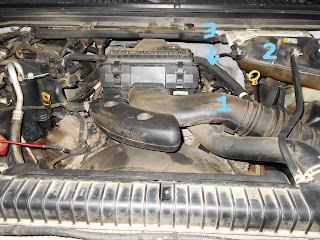At any rate, to do this job you will need the following tools:
3/8 ratchet, and extensions (3", 6", a 3/8" swivel attachment.)
A 9/16" deepwell socket. You can get a 9/16" spark plug socket but they are hard to find.
A 5/8" socket.
A 3/4" socket, deepwell.
A 3/4" wrench.
A 7/8" socket, deepwell.
Penetrating oil. (I use and recommend PB Blaster)
A 7mm socket.
A 8mm socket.
A magnet and/or a parts grabber.
A pair of needle nose pliers.
A six to eight inch length of 3/8"ID hose
Copper (high temperature) anti-seize.
A kit specifically made for extracting broken plugs from Triton three valve engines. Do NOT attempt this procedure without it.
This is the Ford Triton Engine spark plug removal tool. Don't attempt this procedure without this kit.
|
I started with the driver's side of the engine for this procedure.
Step one: remove the air intake hose between the front of the truck and the throttle body.
Step two: unbolt and set aside the degas bottle mounted the firewall.
Step three is to remove the line running from the intake to the valve cover.
Step four: Using the 7mm socket, remove the bolt that holds the coil in place. Immediately place the bolt aside where it will not get lost or worse, find it's way into the combustion chamber.
Step five: Grab the top of the coil, and with a twisting motion, pull the coil off of the plug. (These engines use a coil on plug ignition system, meaning there is one coil per plug.) If the rubber boot should happen to stay on the spark plug, use the needle nose pliers to twist the boot and remove it. It should be notes that these coil packs snap together so if the boot is separated from the coil pack housing itself, it's not the end of the world.
Repeat steps four and five for the rest of the coils on this side.
Step six: Spray some penetrating oil into the spark plug recesses. Let it work for a minimum of thirty minutes. Use this time to remove the coils from the passenger side of the engine, then spray the penetrating oil into those plug recesses.
Step seven: Using the 9/16" socket, ratchet and extensions as needed, remove the plugs from the cylinder head. Be warned, these plugs will be very tight. Go slow, take your time.
Step eight (assuming the plug stayed together): if the plug falls out of the socket upon extraction, Use the magnet to snag the top of the spark plug and carefully pull it out of the recess. if the plug was broken off remove the portion of the plug that is loose.
Step nine: If any of the plugs were broken off, use the extraction tool to get the broken pieces out.
Step ten: Now that the plugs are free of the cylinder, apply the copper anti-seize to the plug threads and the area immediately below the threads. Place the hose over the top of the plug, and use the hose to start threading the plug into the cylinder head. This method prevents cross threading.
The passenger side removal is almost the same as the driver side, with the only real exceptions being some vacuum lines that you can remove to make this job a little bit easier. Some other things that others have tried to make plug removal easier include:
-Let the engine run long enough to get warm.
-Soak the plugs in the block in penetrating oil overnight.
-run one bottle per tank of seafoam for two tanks of gas to clean the carbon off of the plugs.
-Pay someone to do this for you. (But at around $450.00 that's kind of expensive.)
 |
The plug on the left is the new plug, the one on the right was in the engine way too long, as shown by the worn electrode.
|
 |
| This picture shows where the plug has a tendency to break off. Again, you will not get the broken off piece out of the head without the special kit. |
 |
| Here are all eight of the plugs out of the engine...I only broke three of them (new personal record). |


